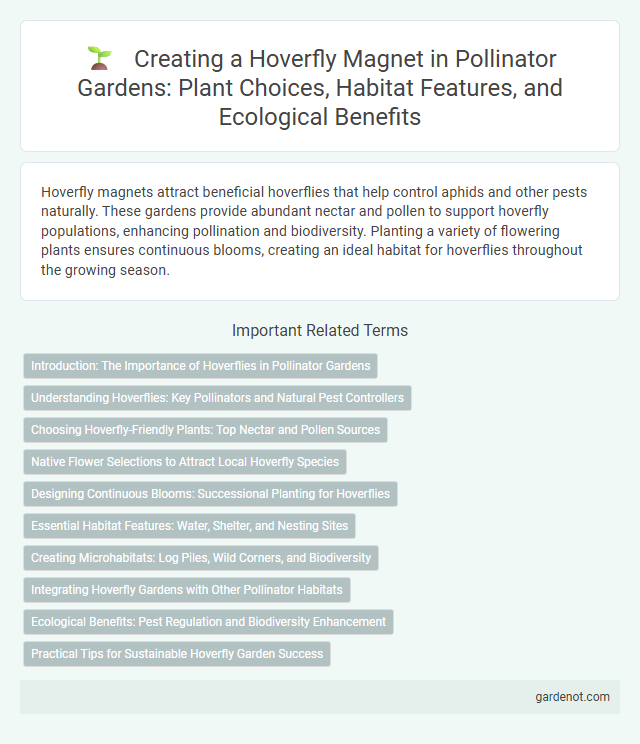Hoverfly magnets attract beneficial hoverflies that help control aphids and other pests naturally. These gardens provide abundant nectar and pollen to support hoverfly populations, enhancing pollination and biodiversity. Planting a variety of flowering plants ensures continuous blooms, creating an ideal habitat for hoverflies throughout the growing season.
Introduction: The Importance of Hoverflies in Pollinator Gardens
Hoverflies serve as essential pollinators in pollinator gardens, contributing significantly to the pollination of various flowering plants. Their presence supports biodiversity by enhancing the reproductive success of native flora and improving fruit and seed production. Creating a hoverfly magnet habitat attracts these beneficial insects, promoting ecological balance and boosting garden productivity.
Understanding Hoverflies: Key Pollinators and Natural Pest Controllers
Hoverflies, vital pollinators in pollinator gardens, contribute significantly to crop pollination and biodiversity by transferring pollen between flowers. Their larvae act as natural pest controllers, feeding on aphids and other harmful insects that damage plants. Creating a hoverfly magnet garden with flowering plants like yarrow, dill, and marigold enhances their presence and supports sustainable pest management.
Choosing Hoverfly-Friendly Plants: Top Nectar and Pollen Sources
Selecting hoverfly-friendly plants enhances pollination by attracting these beneficial insects with abundant nectar and pollen. Top nectar sources for hoverflies include alyssum, fennel, and cosmos, while pollen-rich plants such as dill, coriander, and yarrow support their development. Opting for diverse flowering species across bloom periods ensures continuous hoverfly presence in pollinator gardens.
Native Flower Selections to Attract Local Hoverfly Species
Native flower selections such as goldenrod (Solidago spp.), yarrow (Achillea millefolium), and wild carrot (Daucus carota) create an ideal hoverfly magnet by providing essential nectar and pollen resources. These indigenous plants support local hoverfly species by offering habitat and food sources that match their life cycles and preferences. Incorporating a diverse mix of native blooms ensures continuous forage throughout the growing season, enhancing pollination efficiency in the garden.
Designing Continuous Blooms: Successional Planting for Hoverflies
Designing continuous blooms with successional planting ensures a steady nectar supply for hoverflies throughout the growing season. Select a diverse range of flowering plants with staggered bloom times, including early-blooming bulbs, mid-season perennials, and late-flowering species like asters. This strategy enhances hoverfly attraction and supports their essential role in pollination and natural pest control in pollinator gardens.
Essential Habitat Features: Water, Shelter, and Nesting Sites
Hoverfly magnets thrive in pollinator gardens that provide essential habitat features such as shallow water sources, abundant shelter from wind and predators, and diverse nesting sites like hollow stems and decaying wood. These elements create optimal conditions for hoverflies to feed, reproduce, and contribute to effective pollination. Incorporating native plants with continuous bloom periods enhances the garden's attractiveness and supports hoverfly populations year-round.
Creating Microhabitats: Log Piles, Wild Corners, and Biodiversity
Hoverfly magnets thrive in pollinator gardens that incorporate microhabitats such as log piles and wild corners, providing essential shelter and breeding sites for these beneficial insects. Log piles promote biodiversity by offering decaying wood environments that attract hoverflies and other pollinators critical for ecosystem health. Wild corners with native plants enhance habitat complexity, supporting diverse hoverfly species and boosting overall pollination efficiency.
Integrating Hoverfly Gardens with Other Pollinator Habitats
Integrating hoverfly gardens with other pollinator habitats enhances biodiversity by providing diverse floral resources and shelter, supporting various pollinator species simultaneously. Strategically planting hoverfly-attracting flowers like umbellifers near native bee or butterfly gardens creates a synergistic environment that boosts overall pollination efficiency. Combining habitats also helps stabilize local ecosystems by encouraging natural pest control, as hoverflies act as predators of aphids and other crop pests.
Ecological Benefits: Pest Regulation and Biodiversity Enhancement
Hoverfly magnets in pollinator gardens significantly enhance ecological balance by naturally regulating pest populations such as aphids and thrips through their larval predation. These gardens support biodiversity by providing essential nectar and pollen resources, attracting a diverse array of hoverfly species that contribute to pollination and pest control. Integrating hoverfly magnets promotes sustainable gardening practices, reducing the need for chemical pesticides and fostering a healthier ecosystem.
Practical Tips for Sustainable Hoverfly Garden Success
Plant diverse native flowering species with staggered bloom times to provide continuous nectar and pollen sources for hoverflies throughout the growing season. Avoid using chemical pesticides and herbicides, as these can harm hoverfly populations and reduce their effectiveness in natural pest control. Incorporate habitats such as damp soil patches and decaying wood to support hoverfly larvae development and promote a thriving, sustainable hoverfly garden.
Hoverfly magnet Infographic

 gardenot.com
gardenot.com